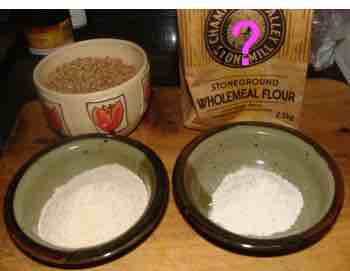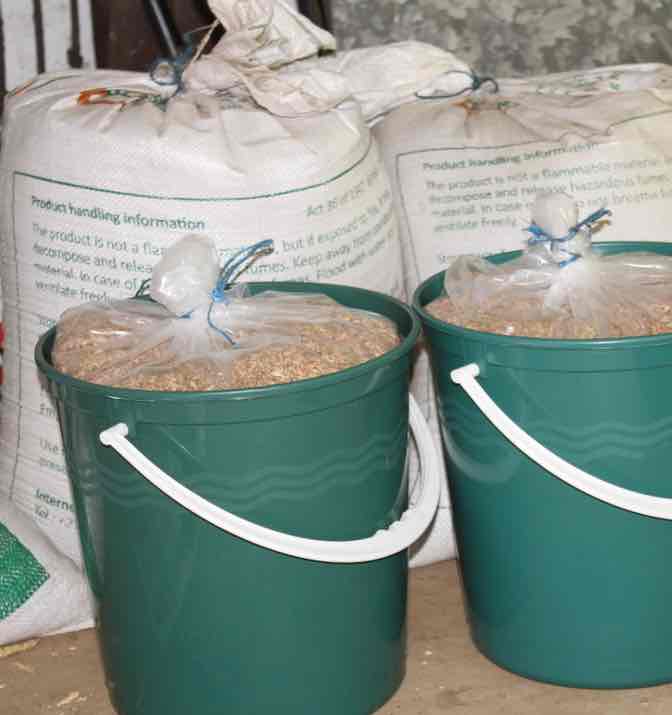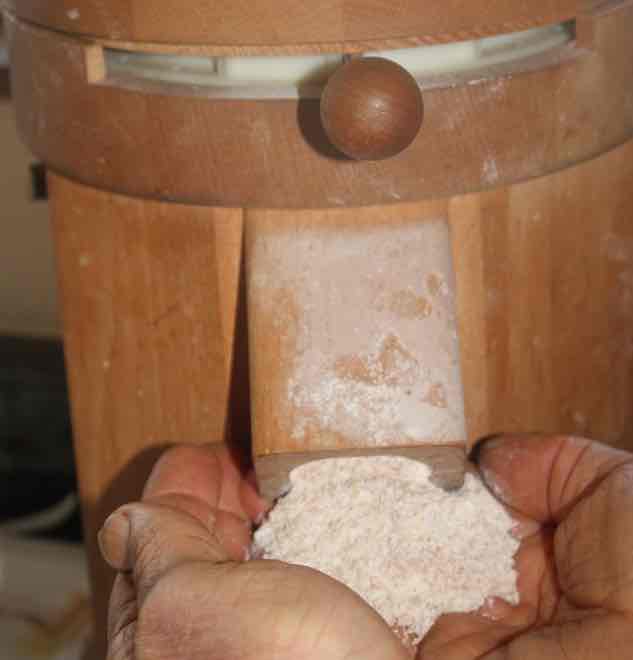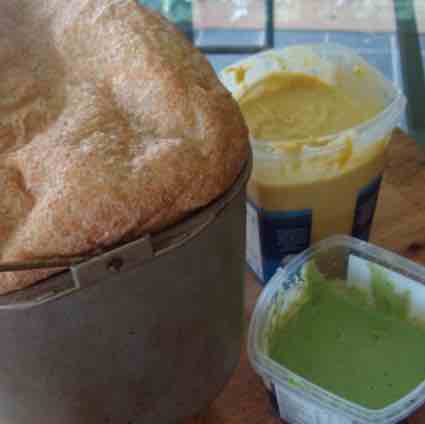- Bernard Preston homepage
- What is a Cyan Zone?
- Storing Wheat
Storing wheat
Storing wheat is for all serious bakers of real bread. That may seem a schlep but for those wanting a ready source of freshly-milled 100% flour, it is overwhelmingly worth the trouble.
Wheat can also then be purchased at a rock-bottom price directly from the farmer. Can you imagine the most tasty and nourishing loaf in the world for less than half a dollar? Five minutes every morning is all it takes; if you've been storing wheat.
Grain has three enemies; well, four really if you include the millers who denude it of the best parts and are duplicitous about the term "wholemeal."
 Are they both really wholemeal?
Are they both really wholemeal?They are the granary-weevil, air and moisture; any one of the three can be devastating for those wanting to store their own wheat.
For those determined to enjoy the nutritional benefits and wonderful flavour of real sourdough-bread, all four enemies have to be faced.

The first is the most difficult. You either have to buy your own grinder or find a small miller who does not separate the three streams. One who will sell you freshly-ground wheat; it is unlikely alas that you will succeed.
Thirty-years ago we bought a Hawo and it mills our wheat faithfully to this day; solid German engineering.
It was expensive but has paid itself off many times over. This is how you grind 100-percent real flour; it's literally a quarter of the price of that from the grocery store.

Purchasing a wheat mill is a great investment, not only for having freshly-ground flour immediately available but also for the nutrition and wellness of the family. The importance of finding an alternative to commercial bread made from refined grain and loaded with chemicals cannot be overstated.
So how much white bread is too much[3]?
One large bagel for breakfast and two slices of white bread for lunch amounts to seven servings of refined flour with a 47% greater risk of stroke, according to research in BMJ[1].
Weevils
To deal with the weevil you either have to buy grain from the shops that has been poisoned with a chemical like Phostoxin, or purchase a year’s supply directly from the farmer. Then after freezing it for two weeks in air and watertight containers, store it in a cool, dry corner. A loaf a day means around 150kg of wheat per annum; more because friends and family will be clamouring.
That means a chest deep-freeze that will take at least one 25 litre airtight bucket for two weeks. The wheat needs to be subjected to this low temperature treatment within three months of harvesting, preferably sooner on the coldest setting; to kill both the weevils and their eggs.
I now use 20-litre buckets; the larger ones were too heavy.
Air and moisture
It is vital to exclude both air and moisture. Aflatoxins are deadly and certainly not to be underestimated. When you remove the bucket from the deep-freeze, humidity obviously will immediately condense on every surface; it has to be kept out.
Finding food-grade airtight buckets and heavy duty plastic bags was our biggest challenge.
Initially we tried placing the plastic bags in the deep-freeze but they tore and I do not recommend it; put them directly into the buckets.
Don’t try and save by buying recycled plastic; food-grade only.
So the first step is to place a large bag in the bucket, fill it to the brim with wheat and tie it tightly with string; squish out as much gas as possible. Then fit the airtight lid. After going into the deep-freeze for two weeks, you can store it in a cool, dry place indefinitely.
Wheat from the tombs of ancient Egypt has germinated and grown.
Now you have a source of wheat for your mill, sans dangerous insecticides for less than 10 pence; 170 sterling for 2200 pounds.
How is that compared to at least 3 pounds per kg? Ask the farmer to put it through a coarse filter to get the worst of the dust from the fields and the chaff out. Make sure that it is completely dry.
Accept there will still be bits of chaff that end up in your bread. I fish the worst of them out as I am feeding the mill; what doesn’t kill, fattens, to use a favourite South African proverb.
Except this bread doesn't add inches. Whole grains are associated with a loss of belly fat[2]. That is because it is a low GI loaf. Sourdough improves it further still.
"Since the beginning of the conflict in Eastern Europe in 2022 the global price of wheat has increased by one-third."
- Katja Keul is German Minister of State
This may all seem intimidating to someone who just wants to bake a couple of decent loaves every week. For me it has been a most satisfying ingredient of the real bread journey. A day in the country finding a farmer and bringing home bags of grain are part of the deal; and then the incredible wonderful-tasting true whole slice that is extremely healthy and doesn’t make you fat.
Lignans and vitamin E
The lignans in the bran help prevent breast tumours; the vitamin E that is a natural anticoagulant alone makes the journey worthwhile. Both nutrients are extracted in the refining of flour. Renowned cardiologist Wilfred Shute says that heart attacks were extremely rare prior to the milling of wheat. We either spend time finding and preparing healthy food or we waste a lot more consulting doctors.
"Cereal fiber intake is associated with lower levels of various inflammatory markers and reduced risk of CVD."
- Journal of the American Medical Association[4]
You won't find much fibre in commercial cereals and bread; it has been extracted to feed the hogs. We are left with inflammation, heart disease and constipation; and the women with breast cancer.
Locating and storing wheat is life-giving; bake your own loaf. It will not make you obese or contribute to diabetes. Do remember though that one slice of wholegrain is enough; keep down the glycemic load.
Storing wheat
Mopping up pesto and hummus with real bread after a hearty meal is so finger-licking good. Storing wheat is worth a thought for those serious about their food.

At the heart of the matter is the difference between real and fake bread; the former is praised in the scientific literature. Whole grains are extremely good for us; those refined are shockingly bad. They make us obese and are a major cause of type 2 diabetes; and non-alcoholic fatty liver disease.
But do keep the Glycemic Load down; one slice is enough.
Sourdough September is a movement in Britain seeking to bring back bread that is tasty and nutritious; a loaf that is interesting and won't make us fat.
Wheat from Eastern Europe
South Africa imported wheat to the tune of R200-million in 2020. The war in Eastern Europe will have huge implications for our bread industry. And the consequences of supporting the invader, by flirting with Vladimir the Terrible in the United Nations are yet to be felt at home.
When browsing use right click and Open Link in New Tab, or you may get a bad gateway signal.
Newsletter
Our newsletter is entitled "create a cyan zone" at your home, preserving both yourself and Mother Earth for future generations; and the family too, of course. We promise not to spam you with daily emails promoting various products. You may get an occasional nudge to buy one of my books.
Here are the back issues.
- Lifestyle and ideal body weight
- What are ultra-processed foods?
- Investing in long-term health
- Diseases from plastic exposure
- Intensive lifestyle management for obesity has limited value
- A world largely devoid of Parkinson's Disease
- The impact of friendly bacteria in the tum on the prevention of cancer
- There's a hole in the bucket
- Everyone is talking about weight loss drugs
- Pull the sweet tooth
- If you suffer from heartburn plant a susu
- Refined maize meal and stunting
- Should agriculture and industry get priority for water and electricity?
- Nature is calling
- Mill your own flour
- Bake your own sourdough bread
- Microplastics from our water
- Alternative types of water storage
- Wear your clothes out
- Comfort foods
- Create a bee-friendly environment
- Go to bed slightly hungry
- Keep bees
- Blue zone folk are religious
- Reduce plastic waste
- Family is important
- What can go in compost?
- Grow broad beans for longevity
- Harvest and store sunshine
- Blue zone exercise
- Harvest and store your rainwater
- Create a cyan zone at your home
Did you find this page interesting? How about forwarding it to a friendly book or food junkie? Better still, a social media tick would help.
- Bernard Preston homepage
- What is a Cyan Zone?
- Storing Wheat
Address:
56 Groenekloof Rd,
Hilton, KZN
South Africa
Website:
https://www.bernard-preston.com